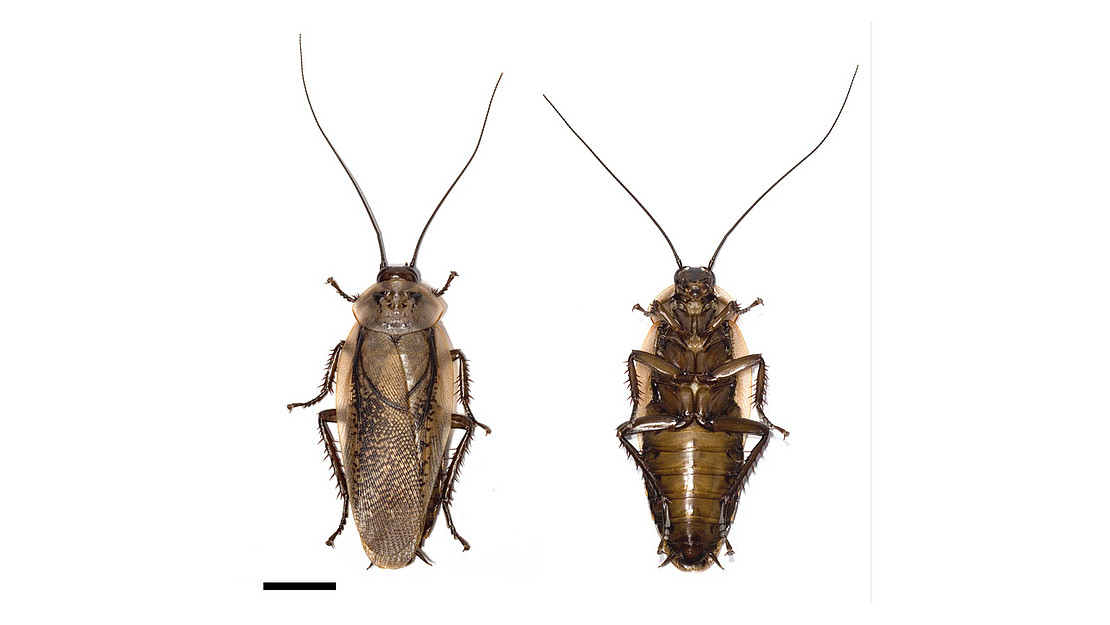This page contains automatically translated content.
Kasseler Biologin erforscht die innere Uhr
 Image: Achim Werckenthin, University of Kassel.
Image: Achim Werckenthin, University of Kassel.Biologische Uhren steuern viele lebenswichtige Prozesse in Menschen und Tieren. Sie entscheiden beispielsweise über Ess- und Schlafrhythmen. Dabei sind im Körper viele kleine Uhren verteilt, die sich etwa im Gehirn, im Auge, der Leber oder der Niere befinden. Hier laufen bestimmte chemische Prozesse in sehr regelmäßigen Kreisläufen ab. Geraten diese Uhren aus dem Takt, werden Mensch und Tier müde, weniger leistungsfähig oder sogar krank. Biologinnen und Biologen der Uni Kassel untersuchen am Beispiel der Madeira-Schabe und des Tabakschwärmers, wie die Vernetzung und das Zusammenspiel der vielen inneren Uhren im Insekt durch Neuropeptide gesteuert wird. Prof. Dr. Monika Stengl, Leiterin des Fachgebiets Tierphysiologie / Neuroethologie an der Uni Kassel, erklärt: „Ob Schabe oder Mensch – auf der molekularen Ebene unterscheiden sich die Prozesse, die sich in den sogenannten inneren Uhren im 24 Stunden-Takt abspielen, kaum. Natürlich gibt es kleine Unterschiede – die generelle Logik ist aber die gleiche.“
Einen Teil des Mechanismus von inneren Uhren bei Madeira-Schaben hat Prof. Stengl bereits erforscht. Sie erläutert: „Eine zentrale innere Uhr befindet sich im Gehirn der Schabe und besteht aus einzelnen Neuronen, die miteinander über Neuropeptide kommunizieren. Durch diese Kommunikation werden Rhythmen im Verhalten und in der Physiologie der Tiere gesteuert – die Schabe schläft beispielsweise immer am Tag und wird zu Beginn der Nacht aktiv. Diese Verhaltensrhythmen wiederum werden durch äußere Rhythmen, sogenannte Zeitgeber beeinflusst. So ein externer Zeitgeber ist zum Beispiel der 24-Stunden-Rhythmus von Tag und Nacht.“ Prof. Stengl weiter: „Die vielen inneren Uhren koppeln sich untereinander und werden durch den Wechsel von Tag und Nacht mit der Umwelt synchronisiert. Lichtimpulse finden also Eingang in innere Uhren und beschleunigen sie, oder bremsen sie ab, abhängig von der Tageszeit.“ So synchronisiert sich auch der 24-Stunden-Rhythmus des Menschen mit dem externen 24-Stunden-Rhythmus von Tag und Nacht. Durch den Eingang von Licht in den Mechanismus der inneren Uhr wird laut Stengl ein Uhr-Protein erzeugt, das wiederum seine eigene Produktion hemmt. Der Rhythmus, in dem dieser Prozess sich vollzieht, dauert in etwa 24 Stunden. Laut Prof. Stengl könne man die inneren Uhren anhand des Spiegels von Uhr-Proteinen in den Schrittmacherzellen ablesen, oder an elektrischen Rhythmen ihrer Zellmembran.
Bereits vor 13 Jahren konnte die Biologin die Schrittmacherneurone ausfindig machen, die im Gehirn der Madeira-Schabe eine zentrale innere Uhr bilden – diese Uhr-Neurone enthalten das Neuropeptid PDF (pigment-dispersing factor), welches andere biologische Uhren synchronisiert. Prof. Stengl erklärt: „Zerstört man dieses Peptid im Körper der Schabe, so wird diese a-rhythmisch – das heißt, dass sie beispielsweise nicht mehr regelmäßig schläft und isst.“ Auch beim Menschen gebe es ein dem PDF entsprechendes Peptid im Gehirn. Dieses trägt als wichtigstes Kopplungssignal unter anderem dazu bei, dass ein Zeitgefühl (z.B. „heute – gestern – morgen“) ausgebildet wird.
Aktuell versuchen die Kasseler Forscherinnen und Forscher weitere Substanzen wie Neuropeptide und Neurotransmitter, die ebenfalls zum inneren Uhrwerk gehören, ausfindig zu machen. Sie wollen das Netzwerk der Uhr-Neurone verstehen, wie genau die zentrale Uhr im Gehirn der Schabe mit vielen weiteren inneren Uhren im Körper der Schabe verknüpft ist. Auch die Auswirkung von einzelnen Neuropeptiden auf das rhythmische Fressverhalten der Schaben interessiert das Forscherteam. Zudem wollen die Biologinnen und Biologen den Zusammenhang zwischen den elektrischen Rhythmen in der Zellmembran der Schrittmacherneurone und den Rhythmen in ihrer Genregulation in den Schaben erforschen. Die Ergebnisse der Grundlagen-Forschung könnten laut Prof. Stengl später zum Beispiel in der Medizin Anwendung finden als Grundlage für Forscherteams, die sich mit dem Einfluss von nicht zeitlich synchronisierten Körperfunktionen auf die menschliche Psyche beschäftigen.
Auch die Auswirkungen von Jetlags und Zeitumstellungen beim Menschen können durch solche Grundlagen-Forschungen langfristig noch besser erklärbar werden.
Tipp von der Biologin für Jetlags
Zu wissen, wie innere Uhren ticken, hilft auch dabei ein bekanntes Phänomen zu erklären: Es ist sehr viel einfacher, die innere Uhr zu verzögern, als sie zu beschleunigen. Wer seinen Körper auf die Winterzeit einstellen möchte oder nach Westen fliegt, sollte sich zu Beginn der Nacht viel Licht aussetzen und sich außerdem sofort dem neuen Schlaf- und Essregime anpassen. Bei einem Flug nach Osten oder der Einstellung auf die Sommerzeit haben wir es weitaus schwerer. Prof. Stengl berichtet: „Man muss über mehrere Tage in der späten Nacht Licht geben, um innere Uhren zu beschleunigen.“
Ein Foto von einer Madeira-Schabe (Foto: Achim Werckenthin, Uni Kassel) unter: http://www.uni-kassel.de/uni/fileadmin/datas/uni/presse/Rhyparobia_maderae_male_Foto_Achim_Werckenthin.png
Ein Foto von Prof. Dr. Monika Stengl (Foto: Sonja Rode) unter: https://www.uni-kassel.de/uni/fileadmin/datas/uni/presse/Prof._Dr._Stengl__Monika.jpg
Kontakt:
Prof. Dr. Monika Stengl
Universität Kassel
Professur für Tierphysiologie
Tel.: +49 561 804 4564
E-Mail: stengl[at]uni-kassel[dot]de